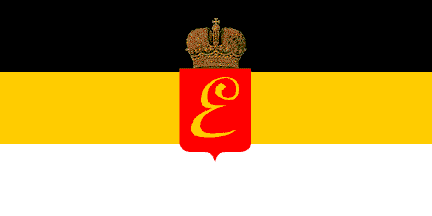
image by Rick Wyatt

FOTW beschäftigt sich mit der Wissenschaft der Vexillologie (Flaggenkunde).
Alle auf dieser Website dargebotenen Abbildungen dienen ausschließlich der Informationsvermittlung im Sinne der Flaggenkunde.
Wir distanziert uns ausdrücklich von allen hierauf dargestellten Symbolen verfassungsfeindlicher Organisationen.
Last modified: 2023-08-05 by valentin poposki
Keywords: imperial flag | orange | catherine 1 (russia) | e | crown: imperial |
Links: FOTW homepage |
search |
disclaimer and copyright |
write us |
mirrors
On this page:
See also:Quoting from [smi75c], Russia adopted a “heraldic flag” …
…on 11 June 1858 for use as a civil flag. Under the influence of German counselors, the government based it on the livery colors of the imperial arms — black and golden yellow, the latter usually represented as orange. A white stripe was added at the bottom lest the flag be exactly the same as the one used by Austria, whose arms also featured a black eagle on gold. White, long a symbol of legitimist monarchies in Europe, was specifically attributed here to the cockades of Peter I and Catherine II. TheI have only seen one instance of theblack-orange-white flag was very unpopular, so much so that the government felt compelled on 7 May 1883 to recognize thewhite-blue-red as official for use on land during celebrations. Hence the flag intended for unrestricted use was rarely seen in prerevolutionary Russia, while the flag restricted to special occasions was in fact the most likely to be hoisted whenever private citizens wished to express their nationality by displaying a flag on land.
In 1858, a black - golden yellow - white horizontal tricolor was
adopted as the civil flag. Black and yellow were the Imperial colors; the white
stripe was added to distinguish this flag from the
Imperial Austrian "Reich" and war flag,
which was a black-yellow horizontal bicolor. The black-yellow-white
flag was highly unpopular and so in 1883, the
civil ensign was adopted as an alternate
civil flag.
Tom Gregg, 09 Jan 1997
However,
the black-orange-red was not officially abolished,
so that Russia had two civil flags from 1883 to 1914.
Tom Gregg, 21 Mar 1999
The Russian nationalists’ black-yellow-white might be based on the
imperial eagle shield.
Anton Sherwood
The story I heard was that the yellow, black and white flag was in the
Romanov livery colors. These date back to the Holstein
Gottorp connection.
They also represent the Russian state as a personal possesion of the Tsar.
It is reported that Nicholas II on a census form decribed heimself as the
owner of Russia.
Arthur Etchells IV, 22 May 2000
Unlike the white-blue-red flag, this
black-orange-white one seems to have no reported variant or
defacement (naval flags, etc.).
António Martins, 09 Nov 2000
There was a report today on TV on the electional
campaign in Russia. On one of those gatherings there
were several “Imperial” flags (black over golden [this
one was in fact very lemon yellow] over white).
Željko Heimer, 09 Jun 1996
The black-orange/yellow-white tricolour is constantly
seen in demonstrations. It used mostly by monarchists and
radical nationalists.
Alexei Arkhipov and Juan Morales, 22 Mar 1999
The Russian Empire’s black-yellow-white flag has indeed become popular
on today’s rightist scene, from innocent traditionalist monarchists to
national-socialist skinheads.
Andre Kovalev, 04 Jul 2002

The black-yellow-white standard is flown over the Summer
Palace in St. Petersburg, which used to be outside the city and
is now a museum. It may also fly over the Hermitage or the
Winter Palace downtown — all favourite royal pasttime places.
Andrej Kovalev, 22 May 2000
This flag is on the top of the Ekaterininskiy Dvorets
(Palace of Emperess Ekaterina II) in Pushkin (former Tsarskoe Selo,
one of summer residences of Russian Imperial Family) near St.-Petersburg.
I saw it this summer and photographed it. There is a museum in this palace
and I think (but is I’m not sure), that it is a flag of this museum.
The letter "E" on the shield means "Ekaterina". The flag’s ratio is
≅1:2.
Andrew Gorodkov, 11 Oct 2000
In a previous program (on Russian TV channel
Kulhtura) was shown a very intersting flag:
the well known “imperial flag”,
with black, golden and white stripes, bearing centrally
a red shield charged with a golden capital hand-written
cyrillic "E" and crowned imperial,
standing for Ekaterina (russian for Catherine).
(On the image above, ratio 1:2 unsure.)
This was shown hoisted nowadays on the top of
a palace, former imperial residence, currently a
museum. It would be interesting to know if this is
a historical flag of a modern “anachronical” creation.
I mean, was designed in a recent date or was used by
Catherine the Great or in any other historical situation?
Are there others standing for other Tsars?
António Martins, 21 Dec 1999, 23 May 2000 and 09 Nov 2000
Meaning of the old flag (1858-1885):
Hosted by: Fanshop-Online.de und Handy-Shop.de
Tipp: Apple iPhone 15 im Shop